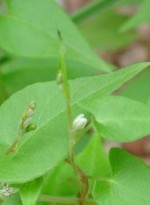 Wild buckwheat is a summer annual vine native to Asia that spread to Europe and then North American. It is found throughout the United States and is especially troublesome in cropland where corn, wheat, and other grains are grown. It prefers sun to part shade, and well-drained soil but adapts to many different soil types depending on the moisture and light. In addition to cropland, wild buckwheat finds its way into gardens and other disturbed sites including waste areas such as roadsides.
Wild buckwheat is a summer annual vine native to Asia that spread to Europe and then North American. It is found throughout the United States and is especially troublesome in cropland where corn, wheat, and other grains are grown. It prefers sun to part shade, and well-drained soil but adapts to many different soil types depending on the moisture and light. In addition to cropland, wild buckwheat finds its way into gardens and other disturbed sites including waste areas such as roadsides.
 Description: Seedlings appear in spring with erect stems that become creeping or twining and usually branch into 2 to 3 stems at the base. These main stems develop additional branches and grow up to 3½ feet long. They twine up any plant or structure they encounter in a counterclockwise direction. Alternate arrow-shaped leaves are carried on petioles that are surrounded by a membranous sheath (ocrea), a structure that distinguishes this weed from field bindweed. The leaves are 1-3 inches long and the lobes at the base of each leaf point towards the petiole, another distinguishing characteristic of wild buckwheat. Small, inconspicuous, greenish–pink to greenish-white flowers are produced on slender spikes (racemes) that arise at the leaf nodes. Black, three-angled seed capsules with green wing-like structures follow; a single plant can produce up to 1,000 seeds. The root system fibrous. Wild buckwheat is often confused with field bindweed but can be distinguished by the presence of ocreae on the stem and the inward pointing basal lobes of the leaves.
Description: Seedlings appear in spring with erect stems that become creeping or twining and usually branch into 2 to 3 stems at the base. These main stems develop additional branches and grow up to 3½ feet long. They twine up any plant or structure they encounter in a counterclockwise direction. Alternate arrow-shaped leaves are carried on petioles that are surrounded by a membranous sheath (ocrea), a structure that distinguishes this weed from field bindweed. The leaves are 1-3 inches long and the lobes at the base of each leaf point towards the petiole, another distinguishing characteristic of wild buckwheat. Small, inconspicuous, greenish–pink to greenish-white flowers are produced on slender spikes (racemes) that arise at the leaf nodes. Black, three-angled seed capsules with green wing-like structures follow; a single plant can produce up to 1,000 seeds. The root system fibrous. Wild buckwheat is often confused with field bindweed but can be distinguished by the presence of ocreae on the stem and the inward pointing basal lobes of the leaves.

 Control: Eradication of wild buckwheat can be accomplished by diligent hand pulling or hoeing of seedlings as they appear. The roots do not sprout so once you pull or hoe up a plant it will not reappear. Removal of plants before they produce seed is vital to reduce the weed in future years. Although postemergent herbicides such as glyphosate can aid in control, they are not usually necessary, or or worth the effort, expense, or harm they do to other plants.
Control: Eradication of wild buckwheat can be accomplished by diligent hand pulling or hoeing of seedlings as they appear. The roots do not sprout so once you pull or hoe up a plant it will not reappear. Removal of plants before they produce seed is vital to reduce the weed in future years. Although postemergent herbicides such as glyphosate can aid in control, they are not usually necessary, or or worth the effort, expense, or harm they do to other plants.